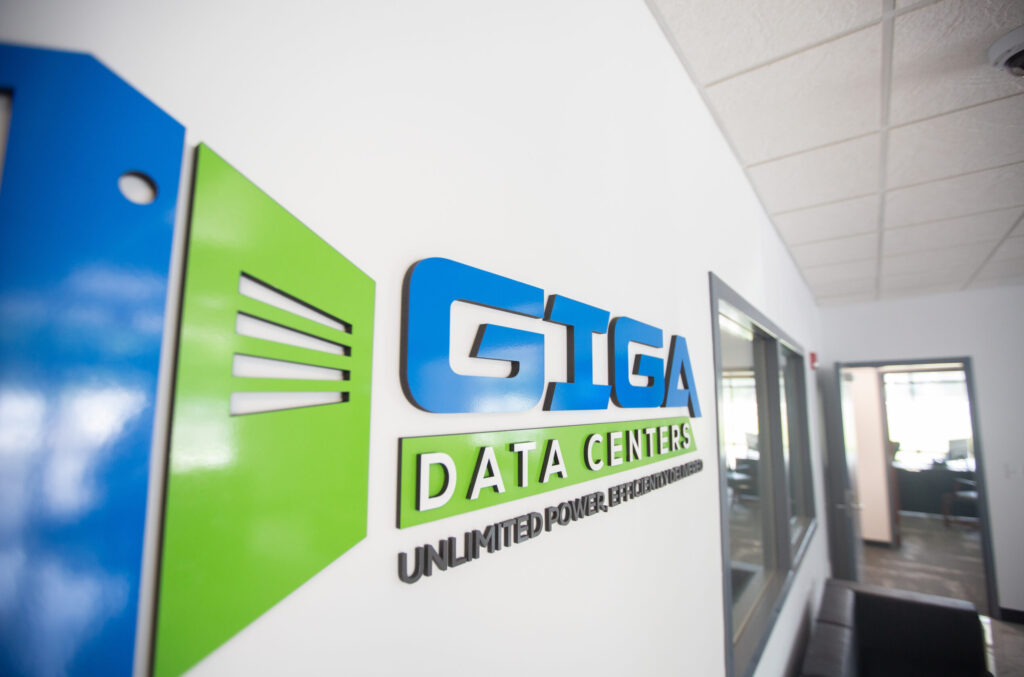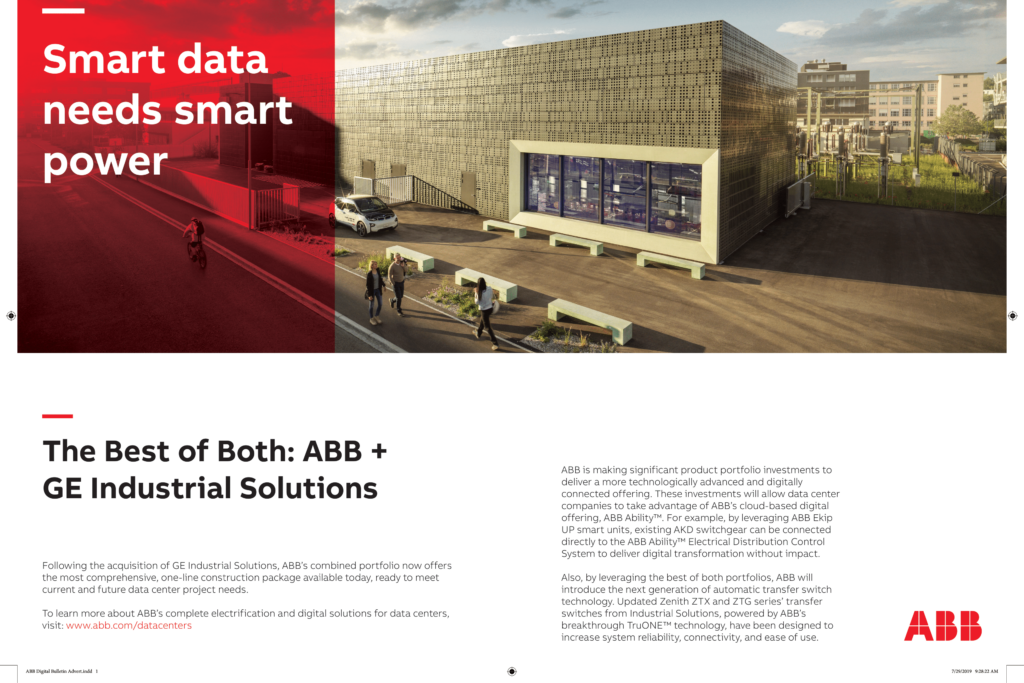
How GIGA Data Centers is delivering hyperscale performance to the colocation market
A business owner will always remember early milestones, no matter how large their company grows or how long the journey lasts.
Those milestones might be measurable – the launch of a new strategy or product – or they might be less obvious, a point on the timeline when a small idea, event or quirk of fortune led the business down an unexpected but fruitful path.
GIGA Data Centers has just passed a milestone that will one day be reflected on fondly by co-founders Jake Ring, Daniel Robbins and James Longacre. A colocation startup with weighty ambitions to disrupt the market, GIGA recently cut the ribbon on its first location in Mooresville, North Carolina.
There was a palpable sense of occasion in June as employees, partners and a variety of guests – more than 150 in total – gathered inside the 120,000 sq.ft. data hall. This was a momentous day for three industry veterans; the day Ring, Robbins and Longacre put forward their vision of a transformed future for multi-tenant, colocation data centres.
Hyperscale providers are already redefining data centre design but Ring, who spoke exclusively with Digital Bulletin in Mooresville, believes GIGA is in place to offer the same service but at a local level.
“Our mission here has really been how to bring the hyperscale level of performance to our customers,” he outlines.
This is a bold undertaking for a company very much in its infancy – but GIGA’s value proposition is compelling. Like the established hyperscale providers, its carrier-neutral offering is based on modular technology; specifically, GIGA’s proprietary WindChill® enclosures that deliver power and scalability at low cost and maximum efficiency.
That core product has been developed over many years, with the recently-formed GIGA incorporating the seventh generation of the technology.
“The hyperscale companies – Google, Facebook, Microsoft and others – had the need to build their own data centres,” explains Ring. “With their resources, they were able to determine that a modular approach was actually going to work better for them.
“Indeed, that’s what my co-founders James Longacre and Daniel Robbins were doing when they were working with Microsoft. They were deploying modular systems that were reducing the cost of operating a data centre and speeding the time to market. We’re using those techniques that the hyperscalers have been using and changing the way that we’re delivering to the multi-tenant, colocation market. It’s very different from what other data centres are still focusing on.”
The combination of product and personnel is what makes GIGA’s three-year target of 15 data centre openings across North America seem achievable. Robbins’ and Longacre’s history with Microsoft – they met as the computing giant began building for a cloud-dominated future – gives GIGA a deep technical skillset. Ring holds valuable leadership experience from senior roles at GE and as founder of DC Blox, a Tier 3 colocation provider in the United States.
It is the WindChill modular system on which GIGA is pinning its hopes for rapid growth and disruption of the sector. While the majority of providers continue to offer the raised floor design prevalent in data centres for more than 30 years, WindChill delivers the essentials of power and cooling within an innovative, ground-up specification.

“Our modular data centre is a private suite; ten racks, 52U high, and what is very unique about WindChill is that every server gets the same amount of air and cooling,” says Robbins. “In a brick-and-mortar data centre, you have air usually coming through the floor and passing through the servers, and this creates hotspots. In ours, you can have a rack or a cabinet at 5kW sitting next to a rack or a cabinet at 35kW, and each will have their heat load removed completely.”
WindChill derives its name from that cutting-edge cooling method. Based on the process of adiabatic cooling, a technique that has been around since the days of Ancient Egypt, the design includes an automated louvre system – controlled by proprietary software run by a Siemens programmable logic controller (PLC) – that manages the flow of air.
Air enters a three-stage filter before passing through a fibreglass adiabatic media, collecting heat from the servers and then exhausting that heat outside the unit. Extra control over temperature and humidity can be applied with variable speed fans and solenoid valves, which are used to drip water onto the media, creating an additional cooling effect with the passing air. Water usage is considerably reduced when compared to traditional techniques. “The WindChill enclosure itself will operate at 80% less power than a normal data centre and use over 95% less water than a chilled water system,” Robbins reveals.
Trust in this efficiency means GIGA can guarantee a PUE, or Power Usage Effectiveness, of 1.15 or lower at its locations. PUE is calculated by dividing the power entering a data centre by the power consumed by the IT servers and equipment, in this instance housed in the WindChill enclosures. With 1.0 being perfect, GIGA’s 1.15 falls well below the industry average of between 1.7 and 2.0.
This efficiency doesn’t, however, come at the expense of density. GIGA offers up to 50kW per rack cabinet and a flexible approach to power provision that means customers only pay for what they use. This means it can comfortably support the hyper-converged and high-performance compute workloads of those building high-density applications.
“I believe it is a huge value proposition,” says Longacre. “You have customers that have multiple applications such as Artificial Intelligence or IoT (Internet of Things), as well as high-performance compute and virtual environments. Normally when you combine those things, companies have to break them apart and treat those racks differently. In our solution, you’re able to consolidate those racks and bring them all together.”
“Our mission here has really been how to bring the hyperscale level of performance to our customers” Jake Ring
Add in the LEGO-like capacity to duplicate WindChill modules to meet client demand – Ring says GIGA can provide additional enclosures within two weeks – and it quickly becomes apparent why the company feels that it is orchestrating significant change in the colocation space.
GIGA’s four strategic partners have and will continue to play a crucial role, with a group of high-profile industrial specialists backing its proposition. Lenovo’s TruScale Infrastructure Services help GIGA deliver compute on-demand to customers, while Nutanix supplies its overlay to that solution, enabling GIGA’s hyper-converged capability delivered as Infrastructure-as-a-Service (or IaaS).
The relationship with Siemens allows GIGA to leverage a standardised design and have true automation and visibility inside its data centres. It achieves this with Desigo™ CC, Siemens’ fully modular and scalable building automation system, and its WinPM.Net complete energy information management solution. Ring praised the speed of Siemens’ deployment and believes the systems will be invaluable as GIGA grows.
He comments: “It was able to do that (deployment) quickly and comprehensively, giving us access to all of the equipment in the (Mooresville) facility, not only from being able to manage and operate but also to control and modify so that we can have true automation. As we’re going forward, being able to have that kind of networked capability will allow us to see the operation of all the different data centres that we’re building through one system.”
ABB is another key partner for GIGA, supplying its TLE Series of UPS (Uninterruptible Power Supply) products to back up GIGA’s power supply. It has also integrated DPA 500, its legacy UPS, in GIGA’s network room, where it required a smaller but scalable solution. Ring is already familiar with ABB’s portfolio – he was an original sponsor for the TLE Series while at GE, which saw its Industrial Solutions division acquired by ABB in 2018.
“I knew what the performance of those products was going to be,” he says. “Its UPS runs at 97% efficiency; it’s one of the highest-performing and efficient on the market. Coupled with the LG lithium ion batteries that we’re using, it meant that we had, really from a total cost of ownership, the best cost and most efficient power support system that we could get.”
The high-level specification on offer from GIGA has seen its Mooresville site achieve significant recognition: it is the first data centre in North America to obtain ‘OCP Ready’ status from the Open Compute Project.
The OCP publically shares modern data centre product designs to hasten the development of hardware in line with accelerating computing demands. A community-focused project, the OCP counts the likes of Microsoft, Google and Facebook among its members and it lays out a number of power and efficiency requirements for data centres to receive approval.
Mooresville has ticked all the boxes, as Ring expands upon: “Through the OCP, we’ve had access to the equipment that’s being used in Google, Facebook, and Microsoft data centres, and now we’re able to use those same switches and benefit from the lower cost. We can have racks delivered and put into use and performance immediately, with the confidence of knowing that it’s operating to those standards.”
A historical look at GIGA’s Mooresville location will reveal a fascinating backstory. Situated in the country’s ‘heart of motorsports’, the 21-acre facility was previously a base for Dale Earnhardt Inc., a NASCAR organisation founded by the legendary racing driver. Auto products were built and tested on site before it was sold to Ginn Racing in 2006, with the area vacated for three years prior to GIGA moving in.
“A friend of mine pointed out to me that this location was something I needed to check out,” Ring reveals. “He was helping a new NASCAR race team find a location in Mooresville when he came across the facility.”
As it happened, GIGA had stumbled upon the perfect spot for a data centre. It is connected directly to two Duke Energy power generation plants next to Lake Norman and is also supported by its own on-premise substation. Additionally, it is served by five major carriers whose MPLS networks are accessible from the facility.The high-level specification on offer from GIGA has seen its Mooresville site achieve significant recognition: it is the first data centre in North America to obtain ‘OCP Ready’ status from the Open Compute Project.
The OCP publically shares modern data centre product designs to hasten the development of hardware in line with accelerating computing demands. A community-focused project, the OCP counts the likes of Microsoft, Google and Facebook among its members and it lays out a number of power and efficiency requirements for data centres to receive approval.
Mooresville has ticked all the boxes, as Ring expands upon: “Through the OCP, we’ve had access to the equipment that’s being used in Google, Facebook, and Microsoft data centres, and now we’re able to use those same switches and benefit from the lower cost. We can have racks delivered and put into use and performance immediately, with the confidence of knowing that it’s operating to those standards.”
A historical look at GIGA’s Mooresville location will reveal a fascinating backstory. Situated in the country’s ‘heart of motorsports’, the 21-acre facility was previously a base for Dale Earnhardt Inc., a NASCAR organisation founded by the legendary racing driver. Auto products were built and tested on site before it was sold to Ginn Racing in 2006, with the area vacated for three years prior to GIGA moving in.
“A friend of mine pointed out to me that this location was something I needed to check out,” Ring reveals. “He was helping a new NASCAR race team find a location in Mooresville when he came across the facility.”
As it happened, GIGA had stumbled upon the perfect spot for a data centre. It is connected directly to two Duke Energy power generation plants next to Lake Norman and is also supported by its own on-premise substation. Additionally, it is served by five major carriers whose MPLS networks are accessible from the facility.
Authorities in North Carolina have worked closely with GIGA and sanctioned sales and use tax exemption on purchased equipment until 2029, including on electricity – with these savings being passed on to customers. Nearby Davidson College, along with services such as the local fire and police departments, have also contributed in a concerted effort from GIGA and the people of Mooresville.
“We have been able to make a difference to Mooresville,” Robbins adds. “We’ve hired everybody locally and this has an impact on this economy. This data centre will put Mooresville on the map as having one of the most energy efficient data centres in the world.”
GIGA now plans to replicate its Mooresville setup throughout North America. Its aggressive growth strategy targets Tier 2 markets where its low-cost offering will be compelling in expensive areas like Massachusetts or California. Specifically, GIGA is exploring sites near major metropolitan areas in order to deliver low-latency performance close to its clients.
David Shepard, recently appointed as GIGA’s Chief Revenue Officer, is one driver behind this expansion plan and he believes the company is primed to scale.
“The beauty of what we have is that it is designed to be reproducible over and over and over again,” Shepard says. “We’re not trying to be just a local provider. We’re looking to expand very aggressively over the next three to five years. As we do that, we know having the ability to reproduce exactly what we have done in Mooresville, and control our costs, makes a big difference. If you’re bespoke every time you need to build another data centre, you’re going to run into problems. You can solve those by what we do with the WindChill.”
Service delivery is the outstanding priority for GIGA. With Gartner estimating that between 70-90% of all companies are now using the cloud, standing out in a data centre market projected to experience incremental growth of $142 billion inside the next two years is ever more challenging. Ring truly believes that GIGA’s cost efficient, customer-centric proposal will move the needle.
“It’s a different approach to take, but if you’re a really focused service organisation, shouldn’t your focus be on how you can help your customer do better and improve their costs?” he summarises. “We see that as a mission that is kind of noble, because we’re trying to help reduce the amount of resources that are having to be deployed.
“There’s a lot of concern about the data centre industry, using so much power that it does. A lot of that power is still not being developed in a sustainable way, so how can we help in that fashion? But also in helping companies in reducing the costs that they have? Because data is the new oil, as we like to say. Content and data never sleeps.”




